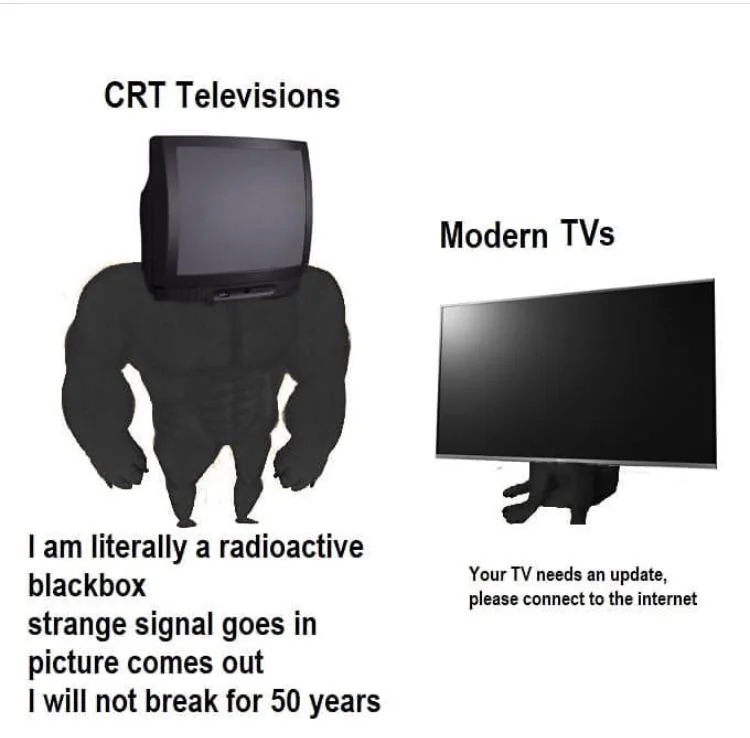this post was submitted on 27 Nov 2023
829 points (95.4% liked)
Memes
9129 readers
318 users here now
Post memes here.
A meme is an idea, behavior, or style that spreads by means of imitation from person to person within a culture and often carries symbolic meaning representing a particular phenomenon or theme.
An Internet meme or meme, is a cultural item that is spread via the Internet, often through social media platforms. The name is by the concept of memes proposed by Richard Dawkins in 1972. Internet memes can take various forms, such as images, videos, GIFs, and various other viral sensations.
- Wait at least 2 months before reposting
- No explicitly political content (about political figures, political events, elections and so on), [email protected] can be better place for that
- Use NSFW marking accordingly
Laittakaa meemejä tänne.
- Odota ainakin 2 kuukautta ennen meemin postaamista uudelleen
- Ei selkeän poliittista sisältöä (poliitikoista, poliittisista tapahtumista, vaaleista jne) parempi paikka esim. [email protected]
- Merkitse K18-sisältö tarpeen mukaan
founded 2 years ago
MODERATORS
you are viewing a single comment's thread
view the rest of the comments
view the rest of the comments


What was wrong with them? They served their purpose just fine for many years
The weighed a ton, they were limited in size, their resolution was terrible, they sucked down electricity...
Their screen was curved the wrong way until they released flat screen TVs
4:3 resolution meant you lost some of the content from movies or you watched them with black bars
Except movies keep changing so now if you want imax at home you need 4:3.
Whatever isn't available at home is what movies will change to to keep themselves unique.
Widescreen has been the movie industry standard for how many decades now? IMAX is its own beast but most movies aren't filmed in real IMAX resolution and now there's digital IMAX which is basically 19:10 which is the same as many TVs...
Movies used to be all 4:3 before tv. It's called the academy ratio. Movies now do 1.85:1 and even 2.39:1. A few even do anamorphic 2.76:1. Anything but the dominant home format.
Major movie studios have mostly used widescreen since the 1950s and all the different ratios you mentioned except 4:3 are better watched on a widescreen TV than a 4:3 TV.
4:3 resolution also means that a lot of good shows will never be watchable in the proper 16:9 format
No, it means 4:3 IS proper format
We had four channels and loved it!
And most people were lucky to have a TV. You were lucky to have a HOUSE! We used to live in one room, all hundred and twenty-six of us, no furniture. Half the floor was missing; we were all huddled together in one corner for fear of FALLING!
They make a high pitched whine
I’m 32 and I can still hear a CRT whine just like when I was a kid. Recently enough I heard a CRT in a retro exhibit before I even saw it.
Use better power supply
Is there a better power supply than cable + wall socket?
Better than the one soldered into the main circuit board of the TV?
Yes! Hire an electrical engineer to improve it for you, you pleb! \s
If you got TV from crapufacturer, then yes.
Sony Trinitrons had whine to them, and those were basically the top consumer display back then. I think my JVC PVM has power supply whine.
Are you serious?
[This comment has been deleted by an automated system]
Sometimes I think about how some technologies could have evolved if they didn't get out of fashion. I always thought it's a bit unfair to compare products made decades ago with new ones and use it as a comparison for the whole technology.
In the case of crts, it would be totally possible to make them with modern aspect ratio and resolutions. The greatest challenges would probably be size, weight and power consumption.
For TVs, that's just because they didn't need any more resolution because the signal they were displaying was 480i (or even worse, in the case of things like really old computers/video game consoles).
My circa-2000 19" CRT computer monitor, on the other hand, could do a resolution that's still higher than what most similarly-sized desktop flat screen monitors can manage (it was either QXGA [2048x1536] or QSXGA [2560x2048], I forget which).
And then, of course, there were specialized CRT displays like oscilloscopes and vector displays that actually drew with the electron beam and therefore had infinite "resolution."
Point is, the low resolution was not an inherent limitation of CRT technology.
They were great until you had to move them. They were clunkier than a sofa because they had no place to hold and weighted as much as a refrigerator
They did break, You know? My father fixed those things, it's that they were actually fixable back then and it was cool. Or maybe it was just russian tech that broke, we lived in one of those ussr sattellite countries.